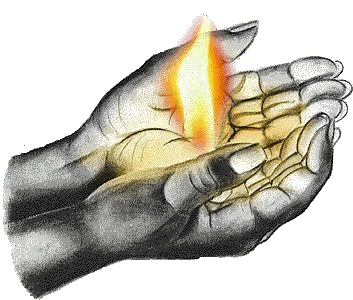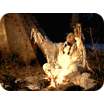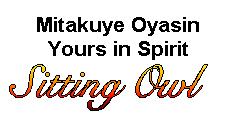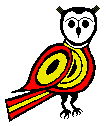|
Main
Menu
External
Pages
|
Psychology
and
Shamanism
  
(From:
‘Earth
People’
Volume
1
Number1)
Now
Playing:
'I
Am
Your
Friend'
By:
Joanne
Shenandoah
I
have
found
that
most
people
do
not
know
what
a
shaman
is,
and
for
those
who
have
got
an
inkling
about
shamans,
they
usually
see
them
as
the
primitive
tribal
witch
doctors
who
sing
and
dance
around
a
patient
doing
all
sorts
of
weird
things.
Firstly
the
word
'shaman'
originally
came
from
the
Tungsic
culture
in
Siberia,
but
is
now
accepted
as
referring
to
the
common
aspects
found
in
every
culture
throughout
the
world,
with
names
such
as
Medicine
Man/Woman,
Sorcerer,
Witch,
and
others
that
could
fill
a
book,
just
like
the
different
names
for
God.
I
cannot
describe
Shamanism
any
better
than
the
way
Teresa
Moorey
does
here:
"Shamanism
is
the
most
ancient
spiritual
practice
of
all.
It
entails
no
dogma,
and
very
few
rules,
for
shamanism
is
about
doing,
experiencing
and
knowing.
It
is
a
path
of
the
heart
-
the
heart
that
opens
and
enfolds
all
of
the
natural
world.
It
is
a
way
of
beauty
and
balance".
Although
it
is
the
most
ancient,
it
is
far
from
being
primitive
and
therefore
useless
in
our
modern
society
of
technology
and
separation
from
the
natural
world.
In
fact
as
we,
as
human
beings,
are
a
part
of
nature,
shamanism
can
help
us
to
get
in
touch
with
ourselves,
and
our
true
human
nature.
The
late
Australian
anthropologist
A.P.
Elkin
says
this
about
the
Australian
Aboriginal
shamans:
“Aboriginal
Medicine
Men,
so
far
from
being
rogues,
charlatans
or
ignoramuses,
are
men
of
HIGH
degree;
that
is,
men
who
have
taken
a
degree
in
the
secret
life
beyond
that
taken
by
most
adult
males
-
a
step
which
implies
discipline,
mental
training,
courage
and
perseverance...
They
are
men
of
respected,
and
often
out
standing
personality...
They
are
of
immense
social
significance,
the
psychological
health
of
the
group
largely
depending
on
faith
in
their
powers...
The
various
psychic
powers
attributed
to
them
must
not
be
too
readily
dismissed
as
mere
primitive
magic
and
‘make-believe’,
for
many
of
them
have
specialized
in
the
working
of
the
human
mind,
and
in
the
influence
of
mind
on
body
and
of
mind
on
mind.”
From
‘Aboriginal
Men
Of
High
Degree
by:
A.P.
Elkin
(1945:
pp78-79)
As
this
shows
the
link
between
shamanism
and
psychology,
I
would
like
to
note
here
that
as
with
psychology,
a
shaman’s
ability
to
achieve
a
proper
lasting
healing,
be
it
physical
or
psychological,
depends
primarily
on
his
or
her
motivation
or
intentions
to
heal.
This
is
because
if
the
shaman
or
psychologist
has
any
other
motives,
e.g.:
money,
income,
livelihood,
or
social
status,
their
heart
is
not
100%
in
helping
a
patient,
and
therefore
there
may
be
important
symbols
and
experiences
of
the
patient
that
they
might
overlook.
A
shaman
or
a
psychologist
must
be
alert
and
focused
as
well
as
patient,
persistent,
caring
or
loving,
courageous,
and
flexible.
In
psychology,
a
psychologist
assesses
a
patient’s
cognitive
skills,
or
in
other
words,
their
ability
to
think
subjectively
and
objectively,
as
well
as
their
understanding
of
their
own
emotional
responses
to
their
experiences.
A
psychiatrist
might
also
assess
a
patient’s
behaviour
based
on
the
chemical
reactions
in
the
brain,
and
the
effects
of
any
toxins
or
drugs
that
may
be
influencing
these
reactions.
The
difference
between
this
and
what
a
shaman
does,
is
that
a
shaman
does
all
of
the
above
as
well
as
assessing
the
patient’s
spirit
or
their
ability
to
recognize
and
understand
the
symbolic
messages
they
might
be
receiving
from
the
spiritual
realms
that
are
trying
to
guide
the
patient
along
their
spiritual
path.
These
messages
can
come
in
the
form
of
dream
images
and
sometimes
come
in
physical
accidents
or
coincidences
as
well
as
omens.
The
most
common
omens
come
in
the
form
of
birds
and
animals
that
are
trying
to
remind
the
patient
of
the
personality
strengths
that
they
could
be
using
and
relying
on,
or
weaknesses
that
they
should
be
trying
to
overcome.
The
real
skill
in
the
shaman
is
to
be
able
to
help
the
patient
firstly
become
aware
of
these
messages
and
then
to
discern
what
the
messages
are
trying
to
say.
This
can
be
quite
difficult,
as
the
messages
are
always
in
a
symbolic,
metaphoric
form,
that
are
created
by
and
therefore
best
understood
by
the
patient,
themselves.
However
because
we
are
all
human
being
with
basically
the
same
nature,
there
are
many
symbols
that
are
common,
and
therefore
a
good
shaman
who
is
very
alert
to
his
or
her
own
human
spirit
can
be
of
great
help
in
translating
these
cryptic
messages.
And
because
we,
as
humans,
are
actually
made
up
of
all
the
‘lower
life
forms’,
e.g.;
we
eat
the
plants
and
animals;
and
we
drink
the
minerals;
our
body
is
made
of
this
planet;
this
is
why,
for
a
shaman
especially,
the
characteristics
or
powers
of
all
bird,
plant,
animal
and
mineral
beings
must
be
clearly
known.
A
shaman
would
of
course
be
most
familiar
with
the
powers
that
are
most
influencing
his
or
her
own
life
as
birth
totems.
But
as
well
as
totems,
which
are
characteristics
of
their
own
soul
and
from
the
universal
forces
that
come
at
the
time
of
their
birth,
a
shaman
can,
by
studying
the
characteristics
or
powers
of
other
beings,
gain
an
understanding
and
use
of
other
powers
which
are
often
referred
to
as
spirit
guides,
spirit
helpers
or
angels.
I
would
like
to
explain
how
this
is
done,
how
it
can
be
experienced
differently
for
different
individuals
and
the
scientific
understanding
behind
all
of
what
I
just
said,
but
because
that
would
fill
an
encyclopaedia,
all
I
can
say
is
that
it
has
a
lot
to
do
with
the
understanding
of
Mythology,
it’s
functions
and
also
quantum
physics.
If
any
one
wants
to
know
more
they
can
talk
to
me
or
read
any
of
Joseph
Campbell’s
work
on
Mythology
(the
best
start
here
would
be
‘The
Power
Of
Myth’
DVD);
and
for
a
scientific
understanding
I
recommend
Fred
Alan
wolf’s
book:
‘The
Eagle’s
Quest
-
A
Physicists
Search
For
Truth
In
the
Heart
of
the
Shamanic
World’.
And
for
a
practical
beginners
guide,
that
also
has
very
good
information
for
advanced
shamans
I
recommend
Teresa
Moorey’s
book
‘Shamanism
-
A
beginners
guide’;
and
for
a
good
overall
guide
on
practising
shamanism,
based
on
the
Hawaiian
tradition
you
can’t
go
past
the
book
‘Urban
Shaman’
by
Serge
Kahili
King,
among
others.
Alternatively
and
preferably,
if
possible,
you
could
let
go
of
ALL
existing
beliefs
about
life
and
reality,
and
open
up
to
the
universal
forces
within
and
around
you,
but
that
is
exactly
what
monks,
mystics
etc.
spend
most
of
their
life
practising.
For
more
info
on
Shamanic
Consciousness,
Shamanic
Tools,
Shamanic
Principles,
Shamanic
Physics,
and
Shamanism
follow
the
links.


Donations
If
you
would
like
to
make
a
donation
to
Sitting
Owl
please
use
this
button.
|